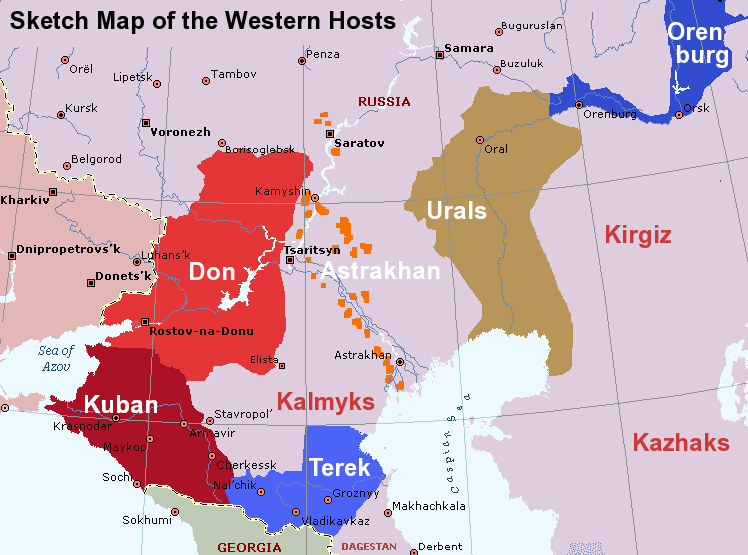
The Urals Host in the Russian Civil War
The Urals Host was settled along the west bank of the Urals River (quite some distance from the Urals Mountains). It was a small and dispersed host. It is also sometimes known as the Yaik Host, as the Urals River is also sometimes called the Yaik.
To the east were the Kalmyk lands and to the west the Kirghiz. Only to the north did the host border fertile areas populated by large numbers of Russian peasants. Not containing any major resources, apart from a little oil, and on no major communications route, the area was always a side-theatre in the Civil War.

Uniforms
The Urals Host soldiers wore standard Cossack dress, with their distinguishing colours being raspberry (often given as "crimson" in books).
Urals Host Cossack Cavalry
Urals Host Infantry
Other Units in the Urals Host Army
Much of this material is also available in Russian at kolchakiya.ru.
A Forgotten Front
The Urals host fought well through 1918 and 1919, before being utterly destroyed. However, as their campaigns were separate from the main theatres – and so few Urals Cossacks made it into exile – their history has been largely ignored outside Russian accounts.
An outline of the Urals Cossacks in the RCW
The Separate Urals Army
Throughout the war the Urals Cossacks proper fought almost entirely on horseback. Partly this was because of the training of the men, partly because the nature of the terrain suited it, but also because the Host never overcame its supply issues. A strategy based on dawn attacks from out of the blue suited both their nature and the position they found themselves. Ammunition shortages meant prolonged exchanges were never possible.
What infantry the Host had, about a quarter of their forces, was largely non-Host in origin. Ex-Imperial officers, stragglers from other armies, peasants and volunteers were all gathered together. Red deserters were added.
Artillery was always in short supply, and ammunition for it even more so.
Eventually a small force of armoured cars were built up, and as the area has wells there was always fuel. A small airforce also grew, though maintenance was a major issue.
The result was an army capable of attacking quickly over long distances, but more or less incapable of taking a fortified position.
Once the Red Army had a sizable cavalry contingent the Urals Cossacks had no ace left. Their destruction, when it came, was swift and final.
Another issue for the Urals Host was a lack of co-ordinated leadership until quite late. It wasn't until March 1919 that a properly unified command was fully in place, and even then local and personal issues continued to hamper co-ordination. Although the Host was not short of officers as such, there was a lack of experienced senior and staff officers. The AFSR sent a few to assist in mid-1919.